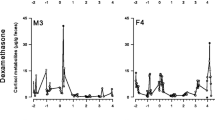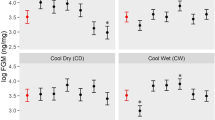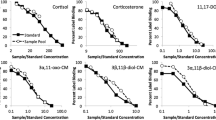Abstract
To develop non-invasive techniques for monitoring steroid stress hormones in the feces of free-living animals, extensive knowledge of their metabolism and excretion is essential. Here, we conducted four studies to validate the use of an enzyme immunoassay for monitoring fecal cortisol metabolites in snowshoe hares (Lepus americanus). First, we injected 11 hares with radioactive cortisol and collected all voided urine and feces for 4 days. Radioactive metabolites were recovered predominantly in the urine (59%), with only 8% recovered in the feces. Peak radioactivity was detected an average of 3.5 and 5.7 h after injection in the urine and feces, respectively. Second, we investigated diurnal rhythms in fecal cortisol metabolites by measuring recovered radioactivity 2 days after the radioactive cortisol injection. The total amount of radioactivity recovered showed a strong diurnal rhythm, but the amount of radioactivity excreted per gram of feces did not, remaining constant. Third, we injected hares with dexamethasone to suppress fecal cortisol metabolites and 2 days later with adrenocorticotropic hormone to increase fecal cortisol metabolites. Dexamethasone decreased fecal cortisol metabolites concentrations by 61% and adrenocorticotropic hormone increased them by 1,000%, 8–12 h after injection. Fourth, we exposed hares to a simulated predator (dog). This increased the fecal cortisol metabolites concentrations by 175% compared with baseline concentrations 8–12 h after exposure. Thus, this enzyme immunoassay provides a robust foundation for non-invasive field studies of stress in hares.





Similar content being viewed by others
Abbreviations
- FCM:
-
Fecal cortisol metabolites
- EIA:
-
Enzyme immunoassay
- DEX:
-
Dexamethasone
- ACTH:
-
Adrenocorticotropic hormone
- 11,17-DOA:
-
11,17-Dioxoandrostanes
- HPA:
-
Hypothalamic–pituitary–adrenal
References
Axelrod J, Reisine TD (1984) Stress hormones; their interaction and regulation. Science 224:452–459
Bamberg E, Palme R, Meingassner JG (2001) Excretion of corticosteroid metabolites in urine and faeces of rats. Lab Anim 35:307–314
Boonstra R, Singleton GR (1993) Population declines in the snowshoe hare and the role of stress. Gen Comp Endocrinol 91:126–143
Boonstra R, Hik D, Singleton GR, Tinnikov A (1998) The impact of predator-induced stress on the snowshoe hare cycle. Ecol Monogr 79:371–394
Bosson OC, Palme R, Boonstra R (2008) Assessment of the stress response in Columbian ground squirrels: laboratory and field validation of an enzyme immunoassay for fecal cortisol metabolites. Physiol Biochem Zool (in press)
Creel S, Fox JE, Hardy A, Sands J, Garrott B, Peterson RO (2002) Snowmobile activity and glucocorticoid stress responses in wolves and elk. Conserv Biol 16:809–814
Cyr NE, Romero LM (2007) Chronic stress in free-living European starlings reduces corticosterone concentrations and reproductive success. Gen Comp Endocrinol 151:82–89
Gądek-Michalska A, Bugajski J (2003) Repeated handling, restraint, or chronic crowding impair the hypothalamic–pituitary–adrenocortical response to acute restraint stress. J Physiol Pharmacol 54:449–459
Häcklander K, Möstl E, Arnold W (2003) Reproductive suppression in female Alpine marmots, Marmota marmota. Anim Behav 65:1133–1140
Haemisch A, Guerra G, Furkert J (1999) Adaptation of corticosterone—but not β-endorphin—secretion to repeated blood sampling in rats. Lab Anim 33:185–191
Hopster H, Bruckmaier RM, van der Werf JTN, Korte SM, Machuhova J, Korte-Bouws G, van Reenen CG (2002) Stress responses during milking; comparing conventional and automatic milking in primiparous dairy cows. J Dairy Sci 85:3206–3216
Jaferi A, Nowak N, Bhatnagar S (2003) Negative feedback functions in chronically stressed rats: role of the posterior paraventricular thalamus. Physiol Behav 78:365–373
Krebs CJ, Gilbert BS, Boutin S, Sinclair ARE, Smith JNM (1986) Population biology of snowshoe hares. I. Demography of food-supplemented populations in the southern Yukon, 1976–84. J Anim Ecol 55:963–982
Krebs CJ, Boutin S, Boonstra R, Sinclair ARE, Smith JNM, Dale MRT, Martin K, Turkington R (1995) Impact of food and predation on the snowshoe hare cycle. Science 269:1112–1115
Mateo JM, Cavigelli SA (2005) A validation of extraction methods for noninvasive sampling of glucocorticoids in free-living ground squirrels. Physiol Biochem Zool 78:1069–1084
Miller WL, Tyrrell JB (1995) The adrenal cortex. In: Felig P, Baxter JD, Frohman LA (eds) Endocrinology and metabolism, 3rd edn. McGraw-Hill, New York, pp 555–711
Monclús R, Rödel HG, Palme R, von Holst D, de Miguel J (2006) Non-invasive measurement of the physiological stress response of wild rabbits to the odour of a predator. Chemoecology 16:25–29
Möstl E, Rettenbacher S, Palme R (2005) Measurement of corticosterone metabolites in birds’ droppings: an analytical approach. Ann NY Acad Sci 1046:1–18
Owen D, Andrews MH, Matthews SG (2005) Maternal adversity, glucocorticoids and programming of neuroendocrine function and behaviour. Neurosci Biobehav Rev 29:209–226
Palme R, Möstl E (1997) Measurement of cortisol metabolites in faeces of sheep as a parameter of cortisol concentration in blood. Int J Mammal Biol 62(Suppl II):192–197
Palme R, Rettenbacher S, Touma C, El-Bahr SM, Möstl E (2005) Stress hormones in mammals and birds. Comparative aspects regarding metabolism, excretion, and noninvasive measurement in fecal samples. Ann NY Acad Sci 1040:1–10
Quinn GP, Keough MJ (2003) Experimental design and data analysis for biologists. Cambridge University Press, Cambridge
Randall DJ, Burgren W, French K (2000) Eckert animal physiology. mechanisms and adaptations, 4th edn. W·H. Freeman and Company, New York
Romero LM, Reed JM (2005) Collecting baseline corticosterone samples in the field: is under 3 min good enough? Comp Biochem Physiol A 140:73–79
Romero LM, Romero RC (2002) Corticosterone responses in wild birds: the importance of rapid initial sampling. Condor 104:129–135
Sapolsky RM, Romero LM, Munck AU (2000) How do glucocorticoids influence stress response? Integrating permissive, suppressive, stimulatory, and preparative actions. Endocr Rev 21:55–89
Teskey-Gerstl A, Bamberg E, Steineck T, Palme R (2000) Excretion of corticosteroids in urine and faeces of hares (Lepus europaeus). J Comp Physiol B 170:163–168
Touma C, Palme R (2005) Measuring fecal glucocorticoid metabolites in mammals and birds: the importance of validation. Ann New York Acad Sci 1046:54–74
Touma C, Sachser N, Möstl E, Palme R (2003) Effects of sex and time of day on metabolism and excretion of corticosterone in urine and feces of mice. Gen Comp Endocrinol 130:267–278
Wasser SK, Thomas R, Nair PP, Guidry C, Southers J, Lucas J, Wildt DE, Monfort SL (1993) Effects of dietary fibre on fecal steroid measurements in baboons (Papio-cynocephalus-cynocephalus). J Reprod Fert 97:569–574
Wasser SK, Monfort SL, Southers J, Wildt DE (1994) Excretion rates and metabolites of oestradiol and progesterone in baboon (Papio cynocephalus) faeces. J Reprod Fert 101:213–220
Wasser SK, Bevis K, King G, Hanson E (1997) Noninvasive physiological measures of disturbance in the northern spotted owl. Conserv Biol 11:1019–1022
Wasser SK, Hunt KE, Brown JL, Cooper K, Crockett CM, Bechert U, Millspaugh JJ, Larson S, Monfort SL (2000) A generalized fecal glucocorticoid assay for use in a diverse array of nondomestic mammalian and avian species. Gen Comp Endocrinol 120:260–275
Acknowledgments
We thank Andrew T. Sheriff for his contribution to this project. The Natural Sciences and Engineering Research Council of Canada, and the Department of Indian Affairs and Northern Development supported this research. We thank Andrew Williams and the Arctic Institute of North America, University of Calgary, for providing facilities at Kluane Lake. The University of British Columbia Animal Care Committee approved all procedures in accordance with the guidelines of the Canadian Council for Animal Care.
Author information
Authors and Affiliations
Corresponding author
Additional information
Communicated by G. Heldmaier.
Rights and permissions
About this article
Cite this article
Sheriff, M.J., Bosson, C.O., Krebs, C.J. et al. A non-invasive technique for analyzing fecal cortisol metabolites in snowshoe hares (Lepus americanus). J Comp Physiol B 179, 305–313 (2009). https://doi.org/10.1007/s00360-008-0314-4
Received:
Revised:
Accepted:
Published:
Issue Date:
DOI: https://doi.org/10.1007/s00360-008-0314-4




